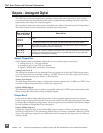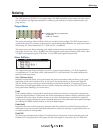
Sample and Bit Rate
25
LED brightness is continuously adjustable from low to high brightness. Hold down the key
and turn the Multi-Function Controller to change brightness levels. All LED’s are adjusted. In stealth
mode (setup menu selected) the LEDs are toggled on and off with the brightness key.
Sample Rate and Bit Depth
When recording to BWF (and WAV fi les) the 744T generates uncompressed, PCM audio fi les at user-
selected sample rates and bit depths. The 744T LCD indicates available recording time based on the
sample rate, bit depth, and number of tracks set for recording. See the Calculating Recording Time later
in this guide to estimate record time.
Sample Rates
When a sample rate is selected for recording, all tracks are recorded at the selected sample rate.
Sample rates are selected among common rates from 32 kHz to 192 kHz. Additionally, non-standard
sample rates can be applied when the 744T is word clocked from an external source.
Sampling Frequency = Available Audio Bandwidth
The sampling frequency is expressed in samples per second (in hertz) and defi nes the number of
times in a second that the analog audio signal has been measured. Sampling frequency determines
the audio bandwidth, or frequency response, that can be represented by the digital signal. A quick
estimate of the maximum bandwidth capable of being represented at a given sample rate is maxi-
mum analog frequency = sampling frequency/2. Higher sampling frequencies allow for wider audio
bandwidth.
Bit Depths
The 744T records at bit depths of either 16 or 24 bit. 24 bit recording provides greater dynamic range
and addition headroom for signal peaks relative to 16 bit recordings. 24 bit acquisition is a signifi cant
benefi t for fi eld production audio tracks.
Bit Depth = Available Dynamic Range
Bit depth defi nes the digital “word length” used to represent a given sample. Bit depth correlates to
the maximum dynamic range that can be represented by the digital signal. Larger bit depths theo-
retically yield more dynamic range. A quick estimate of maximum dynamic range capable of being
represented by a given word length is dynamic range ~= no. of bits x 6 dB. Bit depth is an exponen-
tial measure (exponent of 2), so as bit depth increases, the amount of data it represents increases
exponentially. The majority of fi eld recording is done with 16-bit audio, therefore, each sample is rep-
resented by a digital word of 2^16 (65,536) possible values. 24-bit audio has a word length of 2^24
(16.7 million) possible values per sample.
The 744T has 24 bit analog-to-digital converters. To obtain 16 bit recording the 744T can be set to
dither 24 bit digital signals to 16 bit. The 744T uses a proprietary pseudo-random dither routine for
accurate bit rate reduction. Dither can be defeated in the user menu. Without dither 24 bit audio is
truncated to 16 bit, meaning the least signifi cant 8 bits are discarded.


















